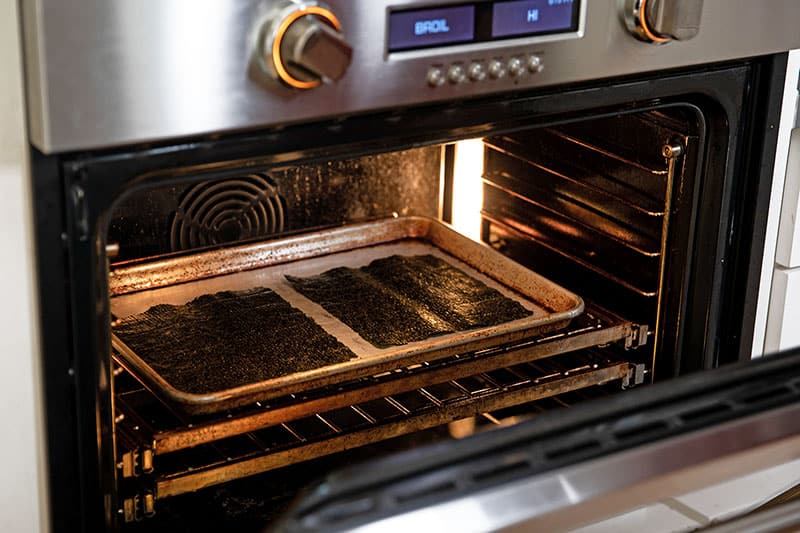Learn how to dry seaweed at home!
Kelp, a type of seaweed, is high in iodine, which is essential for many individuals who do not receive enough of it. Kelp is just one of many types of seaweeds that can be collected, dried, and then eaten.
How to Dry Seaweed at Home
Collect the seaweed
Picking live kelp that is still tethered by its stem is not a good idea. The kelp already has enough issues with sea urchins gnawing off the anchors, powerboats snagging and ripping them off, and so on.
Only collect kelp that has washed up on the shore or is drifting freely.
Here’s a way to know if it is moored without touching it:
- The seaweed is anchored if the “head” is facing upstream. It’s drifting freely if the “head” is pointing downstream. It is drifting if you can still see a lot of the stem floating at high tide. Even anchored seaweed will have a lot of stem at low tide.
You don’t want your kelp to get sandy, so put it in a bag or other closed container before heading towards the beach. This part only applies if you are collecting it from the ocean.
Thoroughly rinse the seaweed
If you get your kelp from the beach, you’ll have to rinse it to get rid of the sand. The ideal spot to do this is immediately where you gather it, in the water. When exposed to fresh water, the kelp becomes extremely sticky, and the sand adheres to it.
In salt water, sand is simpler to wash away than in fresh water.
Rinse your dried kelp in fresh water if you don’t want it to be as salty.
Drying seaweed
Drying seaweed with an oven or dehydrator
Cover with wax paper and roll out into a thin sheet using a rolling pin to create a thin sheet. Thin seaweed sheets should be placed onto silicone mats inside the oven or wax paper to dry seaweed in a dehydrator.
- For drying seaweed in a dehydrator, dry on low (95 degrees Fahrenheit) for up to eight hours.
- For drying seaweed in an oven, dry at 260 degrees Fahrenheit for 3 hours.
When completely dried, the seaweed will be in the form of a flexible and crunchy sheet.
Combining your preferred oils and applying them to one side of the seaweed sheet is a good idea. Season with salts and seasonings of your choice if you so like. Place it on a baking sheet oil side up and broil on low for just a few minutes. Keep a close watch to prevent burning.
Pressing seaweed
This method is meant for artistic purposes:)
Clean your seaweed by rinsing it in clean water. Fill your tray halfway with water and lay your piece of watercolor paper on top. Float your seaweed across the paper until it’s in the right spot. Lift the paper slowly out of the water, ensuring the seaweed stays in place.
Gently dry the area using paper towels before laying it out on newspaper. Cover with extra newspaper and a paper towel. Put it in between two hefty books. Check your pressed seaweed every day and replace the newspaper and paper towel until it is totally dry.
Air drying seaweed
Ideally, you should clean and dry it on the same day as harvesting, but certainly no later than the next day if you want high quality. Rinse it. This removes any grit, snails, small crabs, and more. Seaweeds used in savory dishes can be done either in saltwater or freshwater.
Don’t allow it to soak overnight unless you want a slimy, gelatinous mess in the morning! Also, some seaweeds like dulse will lose their color, and you’ll be left with a pail of purple-colored water. The best way is to plunge the seaweed into a big pail of water by the handful, give them a good swirl around and take them straight out into a colander while you get on with the next batch.
For seaweeds that you plan to use in desserts, like carrageen, wash them thoroughly in fresh water. When drying seaweed, lay the pieces flat on newspaper and place them in the sun. You can also use a clothesline or other type of line to hang the seaweed from.
Storing dried seaweed
While dried seaweed will survive for years without going bad, packed seaweed will last for years without going bad. Even though dried seaweed does not rot, grow mold, or go bad, storing it poorly will result in a quicker loss of flavor and nutritional value. On the other hand, seasoned seaweed has a shelf life of one year or less. When storing dried seaweed, do so in airtight containers. Leave inside a pantry out of direct sunlight.
Any type of dried seaweed may be frozen, and it can keep for more than three years before becoming stale if kept frozen. Before freezing, seaweed should be vacuum packed or moved to an airtight container or freezer-safe bags to prevent it from drying out. Avoid opening the packaging right away when removing it from the freezer, as it can allow moisture in, causing the seaweed to become soggy. To crisp up soggy seaweed, broil on low for a few minutes.
Here is a great video about seaweed and its benefits.





